Businesses use artificial intelligence (AI) for content marketing to speed up the content production process.
But that’s not all.
They also use AI to get content ideas, generate working drafts, assist with creative and SEO strategies, and write better for their target audience.
And you can, too.
Ready to learn how to use AI for content marketing? Let’s dive in.
The Benefits of Using AI for Content Marketing
AI is making it easier and faster to create engaging content. But it’s not just about efficiency.
AI can also shape your creative strategy and help you come up with fresh ideas.
Here are more specific benefits of using AI as a part of your content marketing processes:
- AI accelerates content development by streamlining the writing process. It suggests topics, generates outlines, and even drafts content.
- AI improves scalability by increasing your content output without needing more writing resources
- AI reduces costs throughautomating some content creation tasks. Which makes the content creation process more efficient and cost-effective.
But even though AI can be a huge help, it’s not perfect.
The Challenges of AI Content Marketing
AI is a great tool to support your content production efforts. But it also has some drawbacks:
- Lack of accuracy: Sometimes, AI doesn’t get the facts right. It can misinterpret data, provide outdated information, or even “hallucinate” (invent false information). This means you always need to double-check AI-generated content before publishing.
- Risk of plagiarism: AI tools might generate content that’s too similar to existing material on the web. Which leads to plagiarism concerns.
- Lack of human touch: AI-generated content can sometimes feel impersonal, inauthentic, and even robotic
- Wrong tone of voice: AI tools struggle to hit the right tone of voice. The copy sometimes sounds too formal, too casual, or like something is just “off.”
Read on to learn how to navigate these challenges. And effectively integrate AI into your content marketing strategy.
6 Ways to Use AI for Content Marketing
1. Generating Content Ideas
AI can suggest topics that are likely to resonate with your audience.
This provides a steady stream of inspiration to keep your content fresh and engaging. And can help you create relevant blog articles and social media posts.
Here’s how you can use AI to generate content ideas with ContentShake AI.
Let’s say you’re the content manager of a pet care brand. And you want to find content ideas about food.
The tool will ask questions about your business. Enter your responses and click “Continue.”
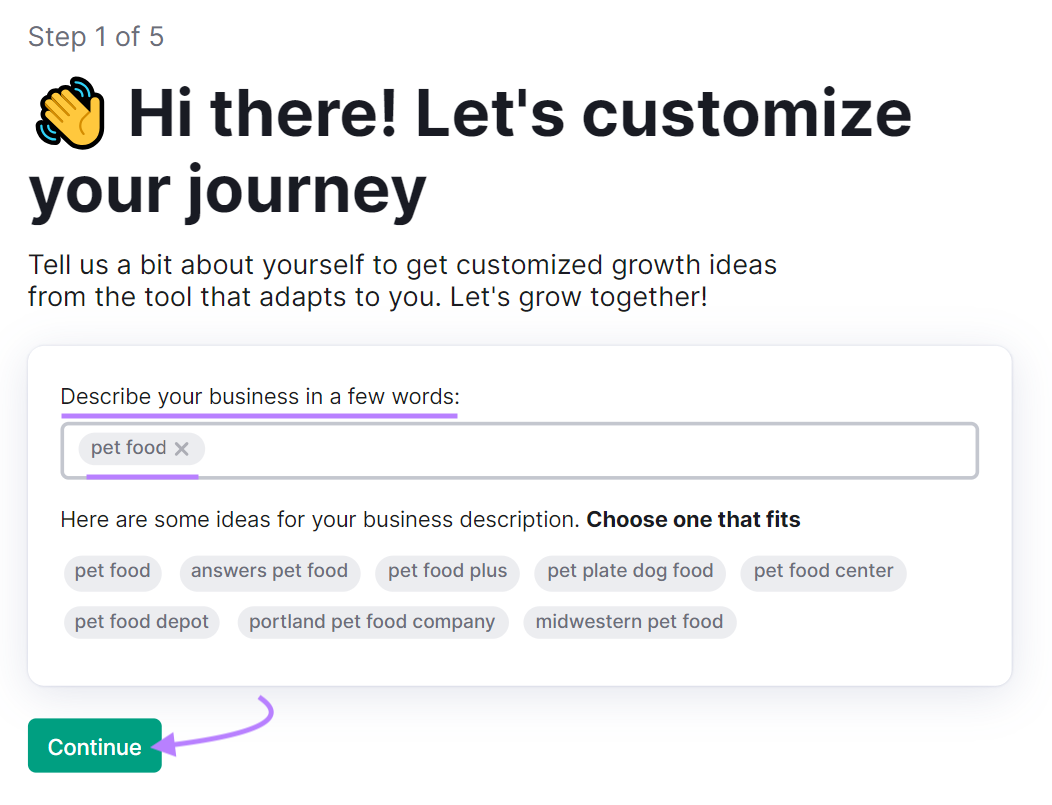
You’ll reach the home screen. With a bunch of ideas based on your industry, grouped by topic.
Click on the topic bubbles found at the top of the page, like “best puppy food,” to get more ideas. Or click “My own idea” to add your own idea and get more suggestions.
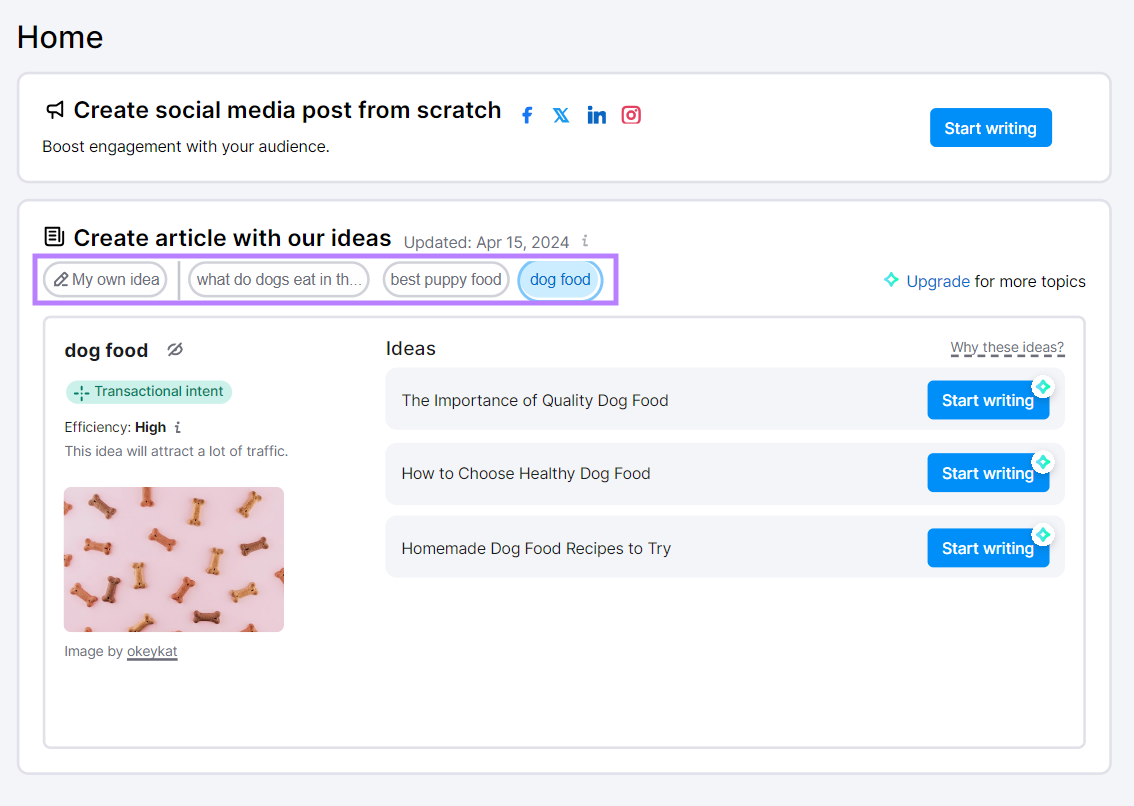
For each topic, the tool tells you the following:
- Search intent: What searchers want to see when they use a keyword
- Efficiency score: How rewarding using a certain topic will be based on search volume and keyword difficulty
- Traffic information: How many visitors you’re likely to get from writing about that topic
For example, “best puppy food” has commercial intent. Meaning most articles ranking for this keyword are probably a list of product comparisons.
It has a high efficiency. Meaning the target keyword probably gets a good number of searches per month. And isn’t too difficult to rank for.
The tool also says, “This idea will attract a lot of traffic.” Meaning you’re likely to get lots of website visitors if you rank well for this topic.
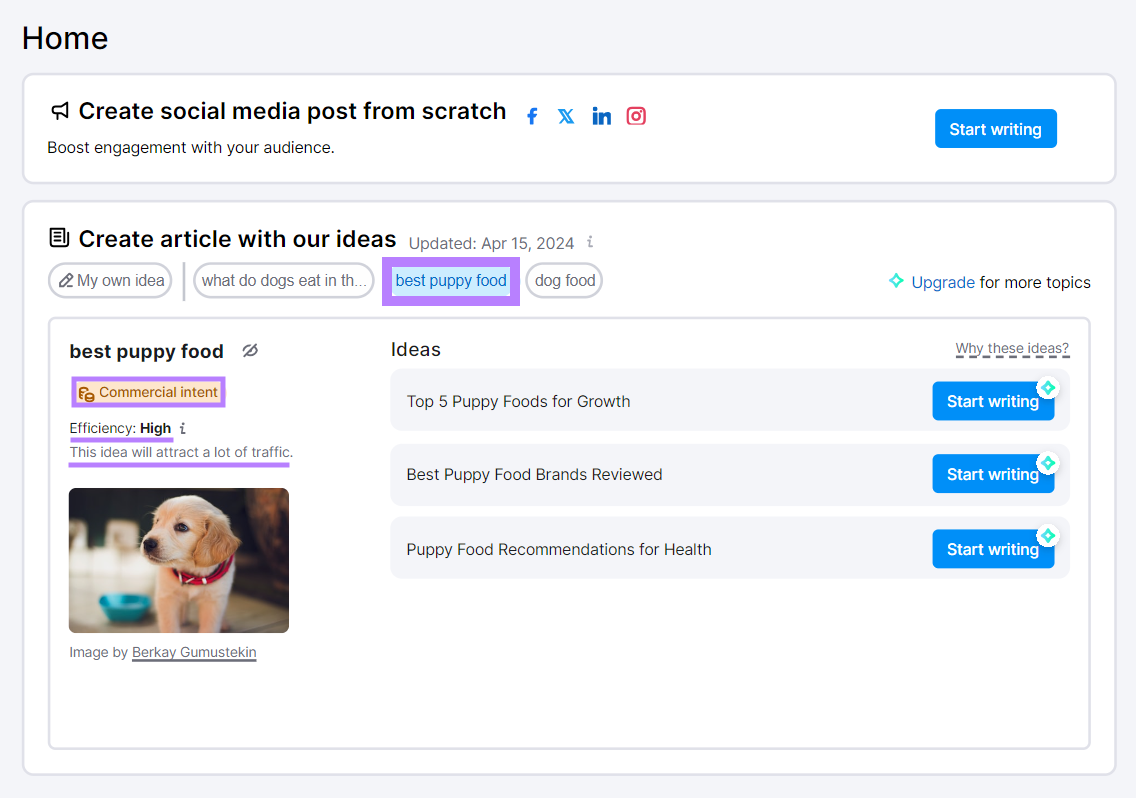
Generated ideas under the “ food” topic include:
- “The Importance of Quality Food”
- “How to Choose Healthy Food”
- “Homemade Food Recipes to Try”
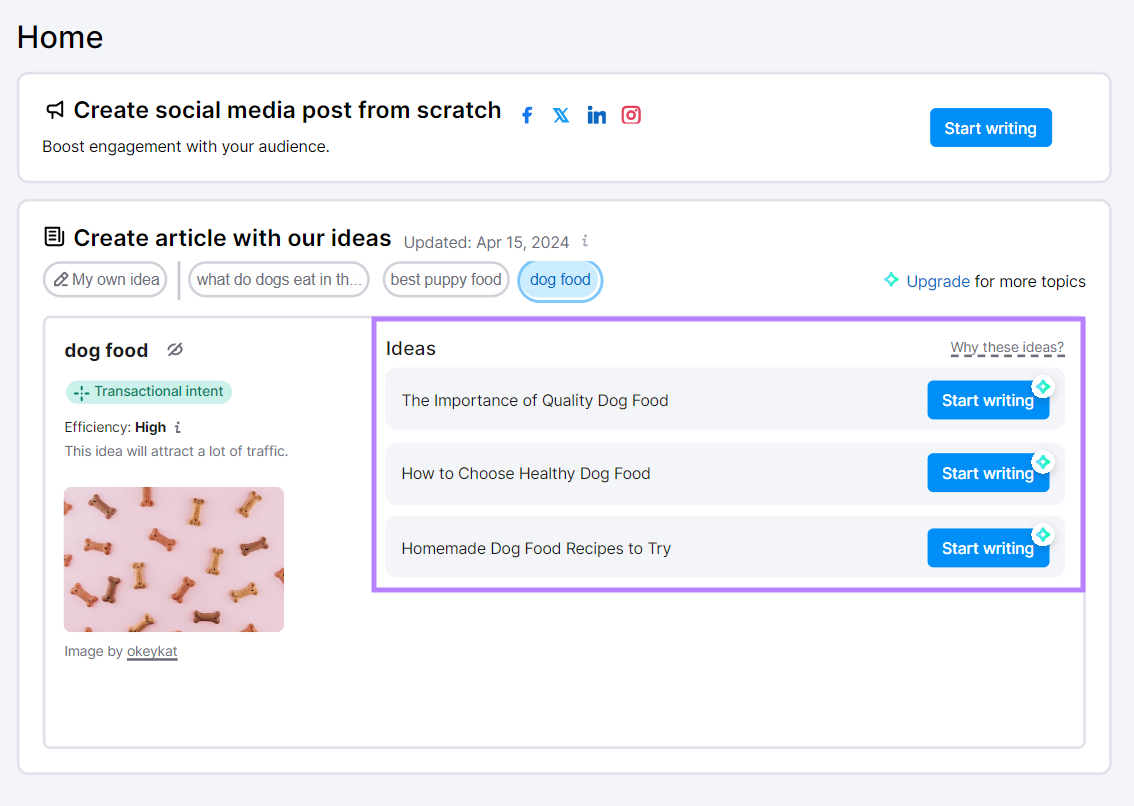
These ideas and insights can help you create content that meets user needs and attracts traffic to your site.
2. Writing Drafts
Once you’ve decided what you want to write about, you can use AI to create drafts for you.
This speeds up the content creation process. Because it’s often easier to edit a draft than write an article from scratch.
But take note:
Always edit AI-generated drafts for accuracy. AI doesn’t always produce the most accurate outputs. So double-check that there are no inaccurate claims within the generated draft.
You can draft content with the ContentShake AI tool.
Use one of Semrush’s ideas. Or add your own.
Then click the “Start writing” button.
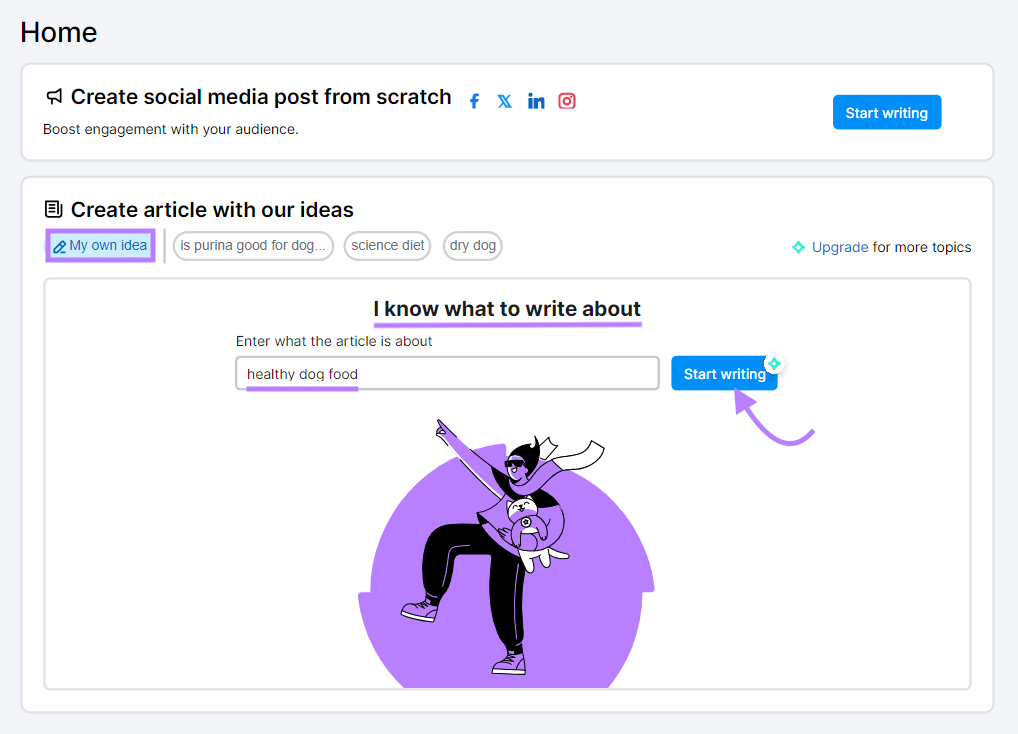
The “Create an article” window will pop up. Enter a title or choose one of the suggestions.
You can toggle between “Suggested by AI” and “Used by Competitors” to choose an engaging title.
Enter your target keyword, word count, tone of voice, and readability level. When you’re done, hit “Create article.”
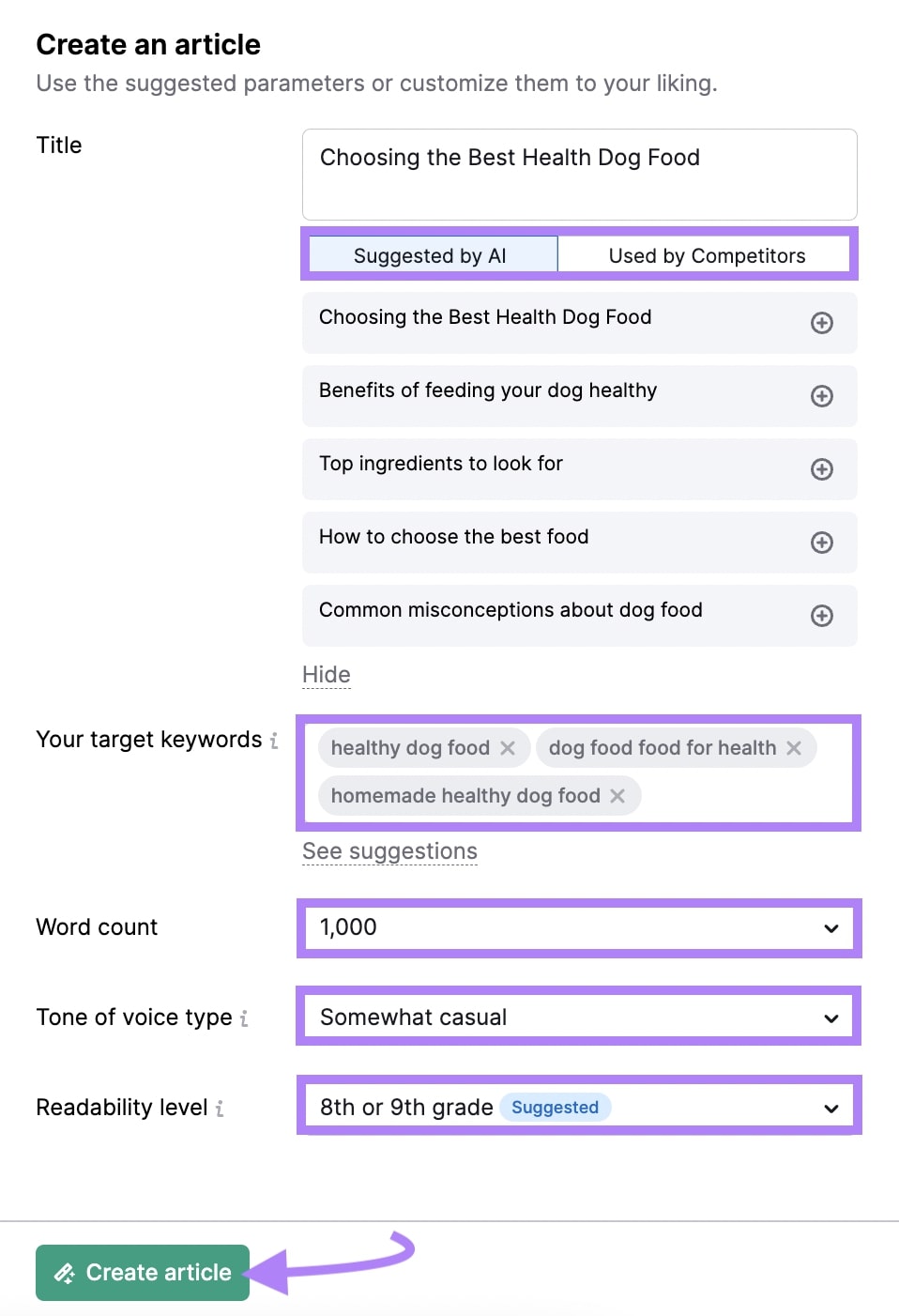
AI will create a draft for you, complete with images. Like this one about “How to Choose Healthy Food”:
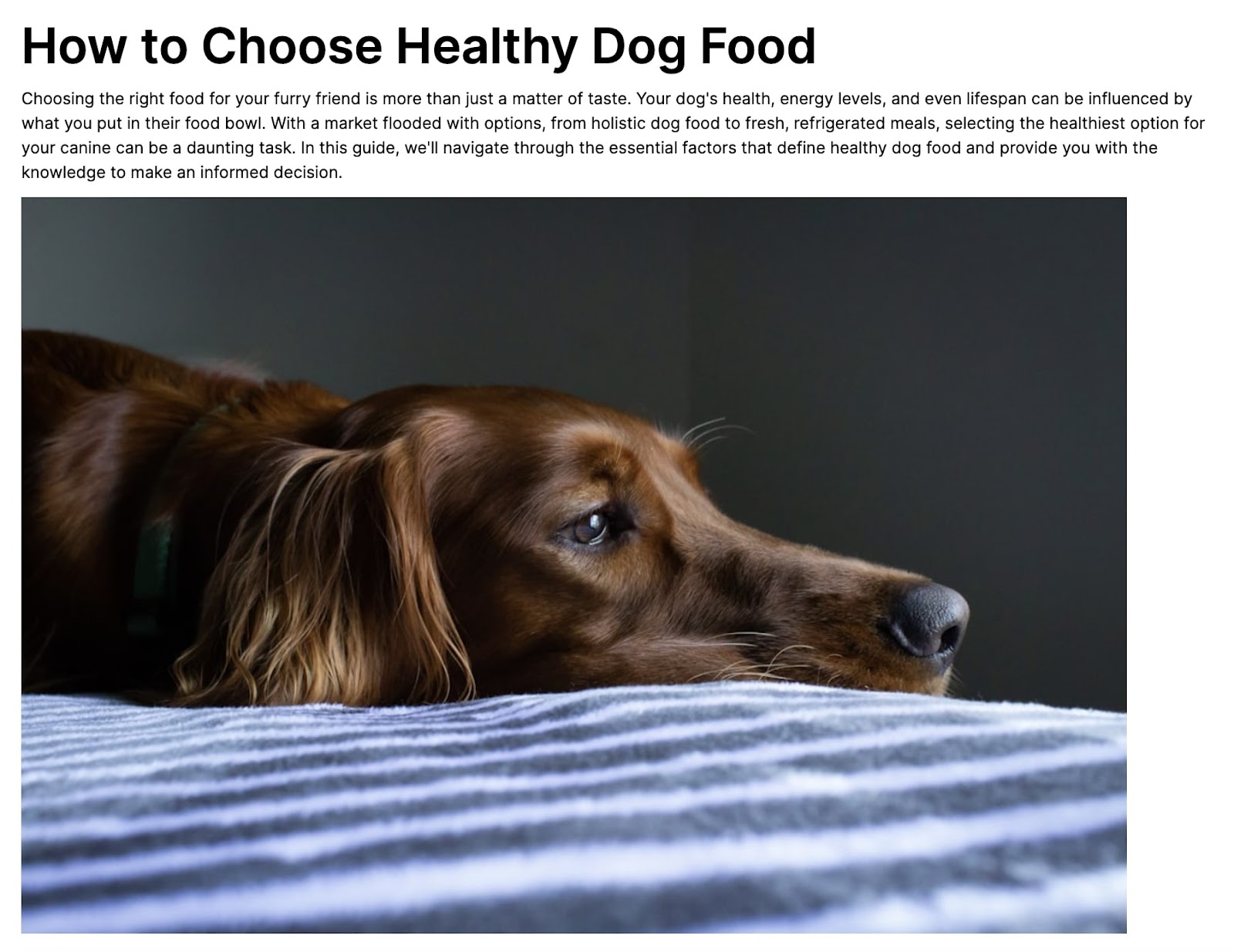
Look through the article to see if you’re mostly happy with the output. If not, click “Go to regenerate” to generate a new draft with different parameters.
Or click “Go to editor” to modify it yourself.
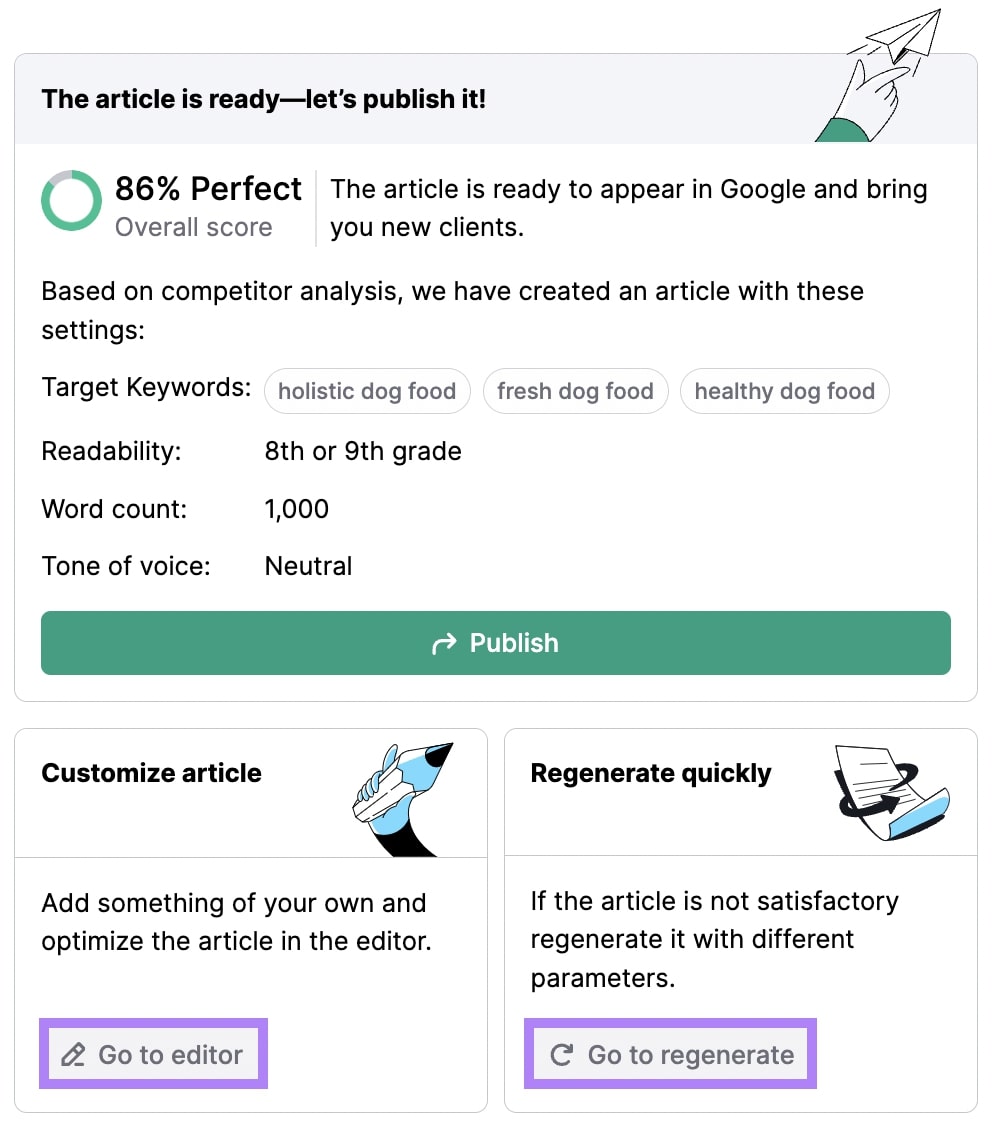
AI can help you get started quickly. It gives you ideas and a promising first draft to adapt and expand on.
But creating high-quality content still requires a human touch. So the first draft will still need some input from you to be effective.
3. Optimizing Content for Search Engines
You can use AI to check if your content is optimized for SEO.
Semrush’s SEO Writing Assistant can help you understand if your draft is optimized and ready for publishing. And provide suggestions on how to improve your article.
To get started, copy and paste your content into the field provided. Then, enter your keywords and the location of your target audience. And hit “Get recommendations.”
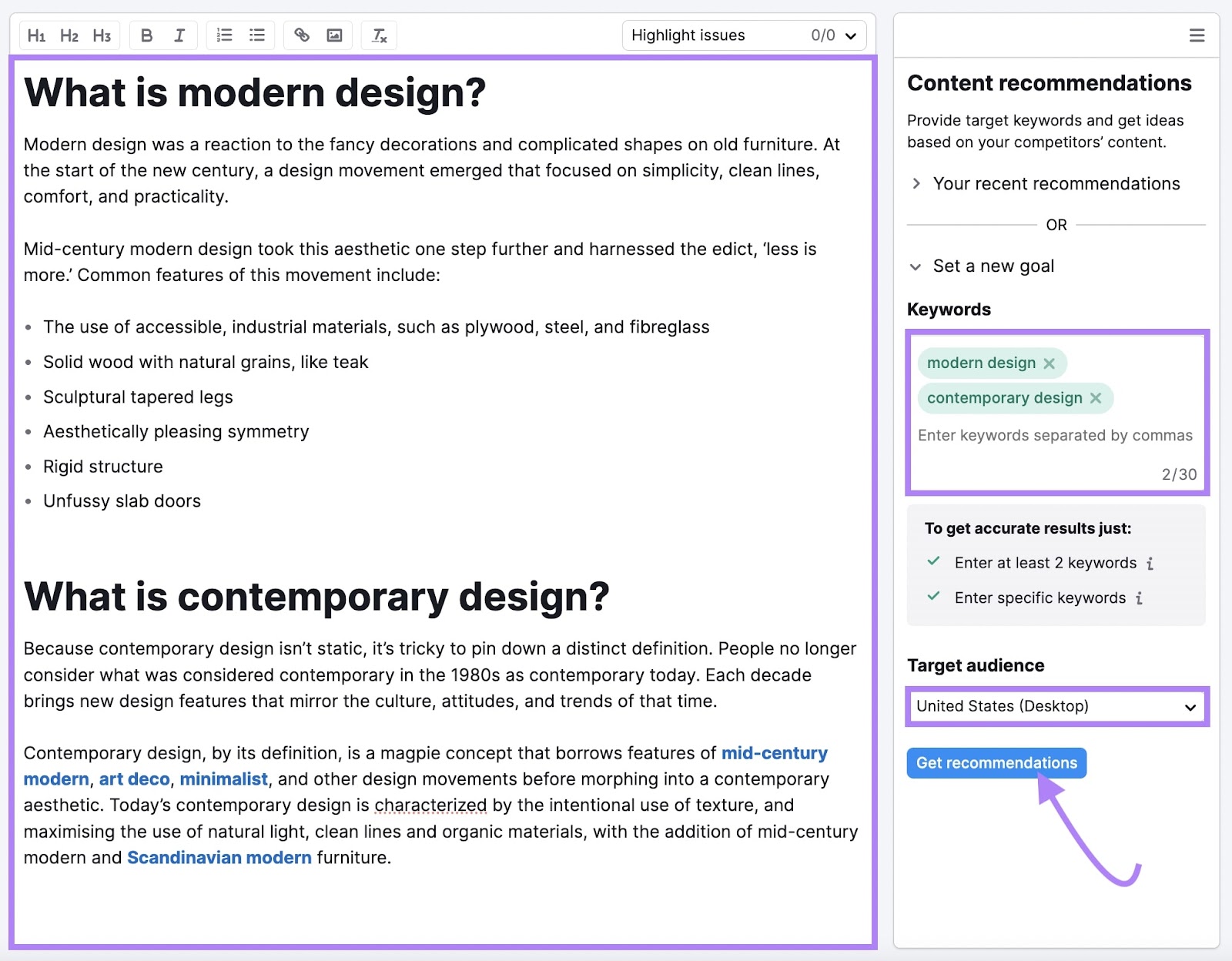
The tool analyzes your text. And shows you an overall score out of 10 for your article. This is based on readability, originality, SEO, and tone of voice:
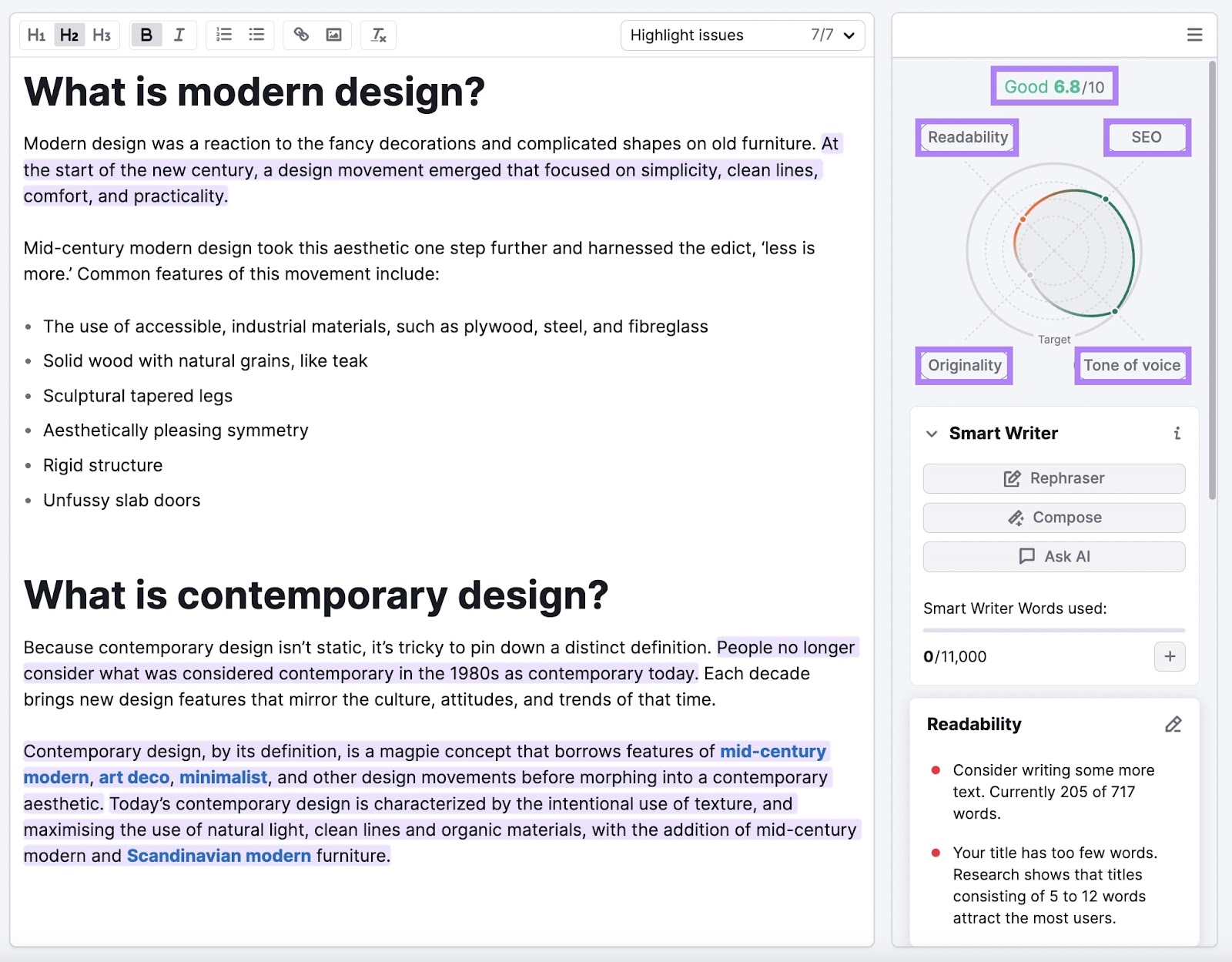
Scroll down to see more feedback on readability and SEO. For example, it might tell you that you are overusing certain keywords. And make recommendations for keywords you could use more of.
It also provides feedback on the tone of voice. It flags any sentences that are too casual or too formal. And prompts you to remove unnecessary filler words.
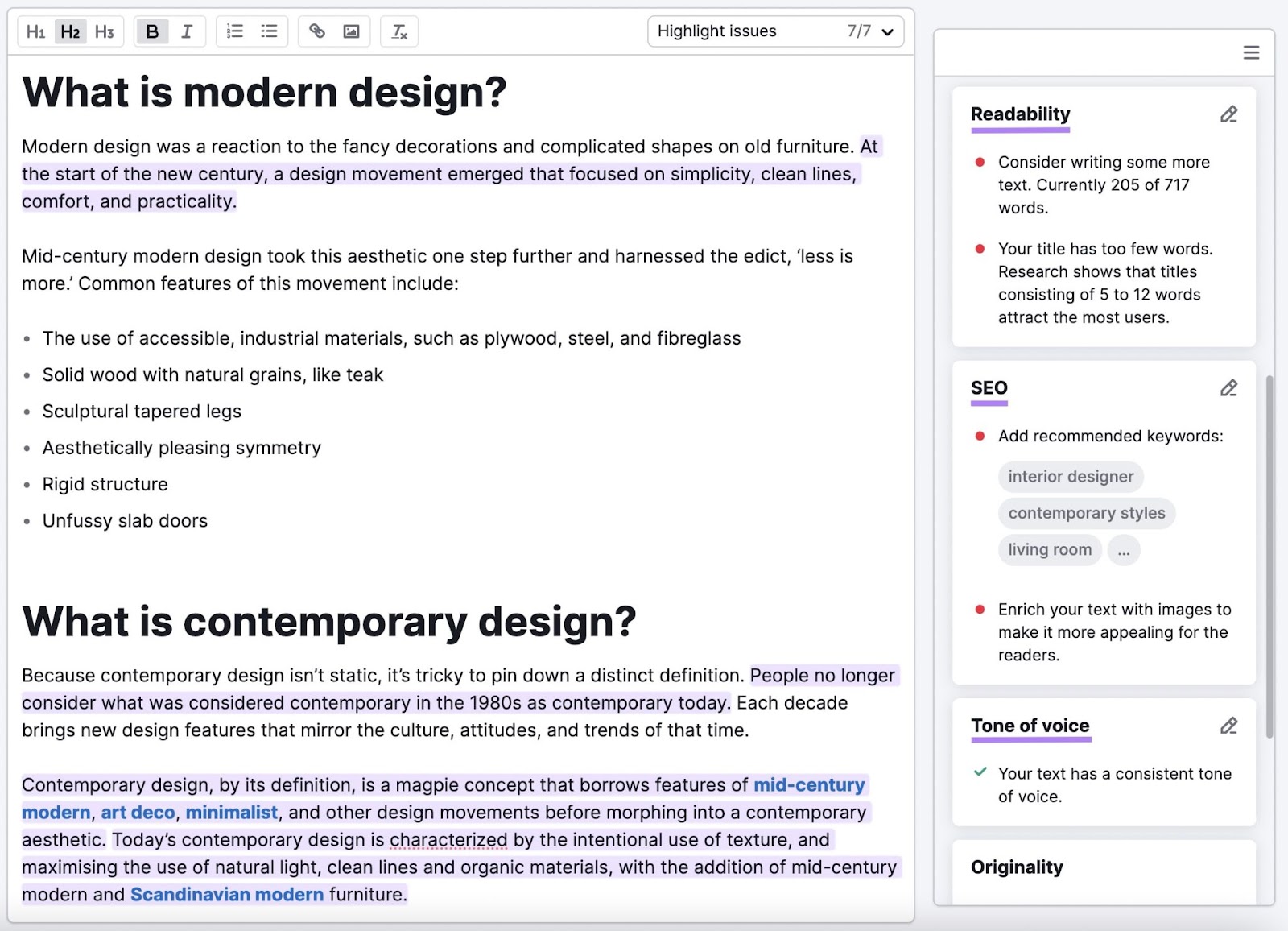
This feedback can help you improve and optimize your article before you publish it. So you get the best results from your content.
4. Editing Content for Your Audience
You can use an AI tool like ChatGPT to better understand your audience’s needs and interests. AI can also review content drafts and tell you if they’re relevant for a particular audience.
Here’s how to do both those things:
Let’s say you’re writing content for first-time puppy owners.
First, sign up for a free ChatGPT account (or a similar tool), if you don’t already have one.
Then, ask ChatGPT about your target audience’s needs, interests, and challenges. Like this:
“I’m creating content for first-time puppy owners. What are their needs, interests, and challenges?”
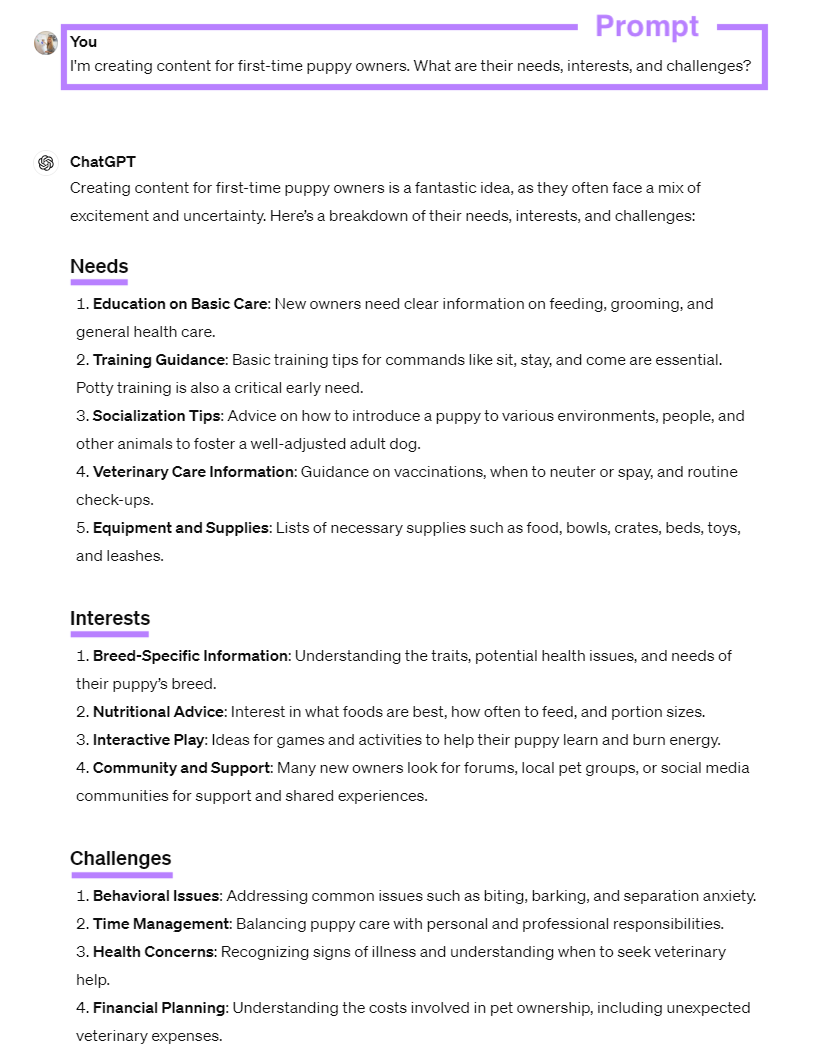
Use these insights to inform your content strategy. So you can plan content that aligns with your audience’s specific interests and challenges.
In this case, some content ideas for your target audience could be, “how to train a puppy” or “what kind of food is best for puppies.”
After you write your content, you can share your drafts with the AI tool. And ask if your content meets your audience’s needs. Or who the content would be suitable for.
To do this, paste the content into the tool and ask for feedback.
For example, let’s ask ChatGPT if this draft on “How to Choose Healthy Food” is suitable for our audience of first-time puppy owners:
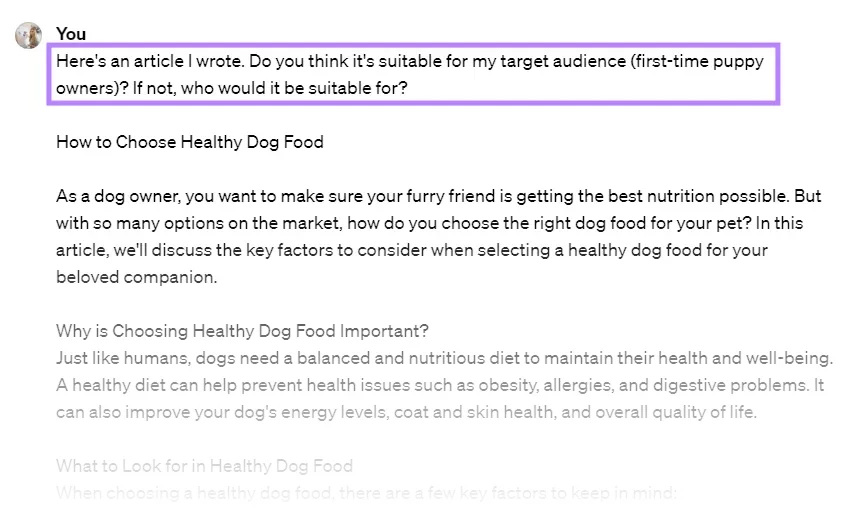
The tool scans the article and provides ideas on how to make the content more relevant for your audience. Like incorporating more puppy-specific advice and practical examples for different puppy breeds or sizes.
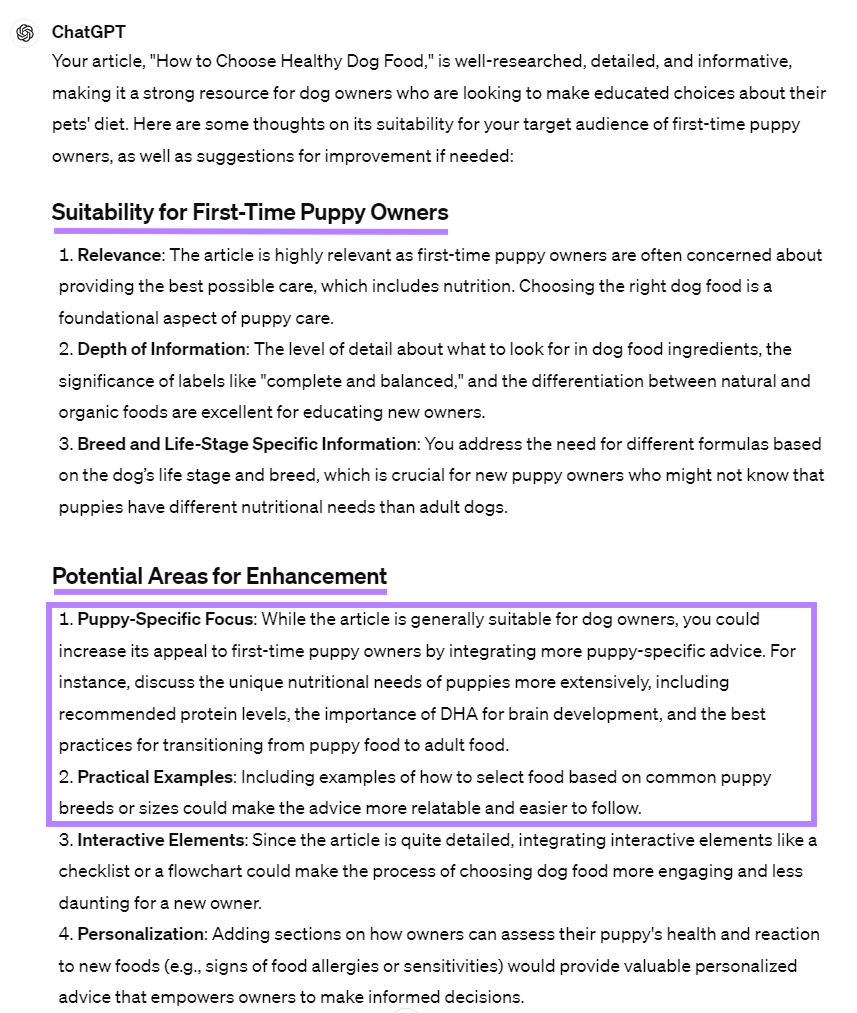
If you want to target different groups of people, you can ask the AI tool which audience the content is most suitable for.
Let’s say you’re trying to reach first time puppy owners, experienced owners, and pro trainers. You can ask the AI tool which audience is most likely to be interested in the content.
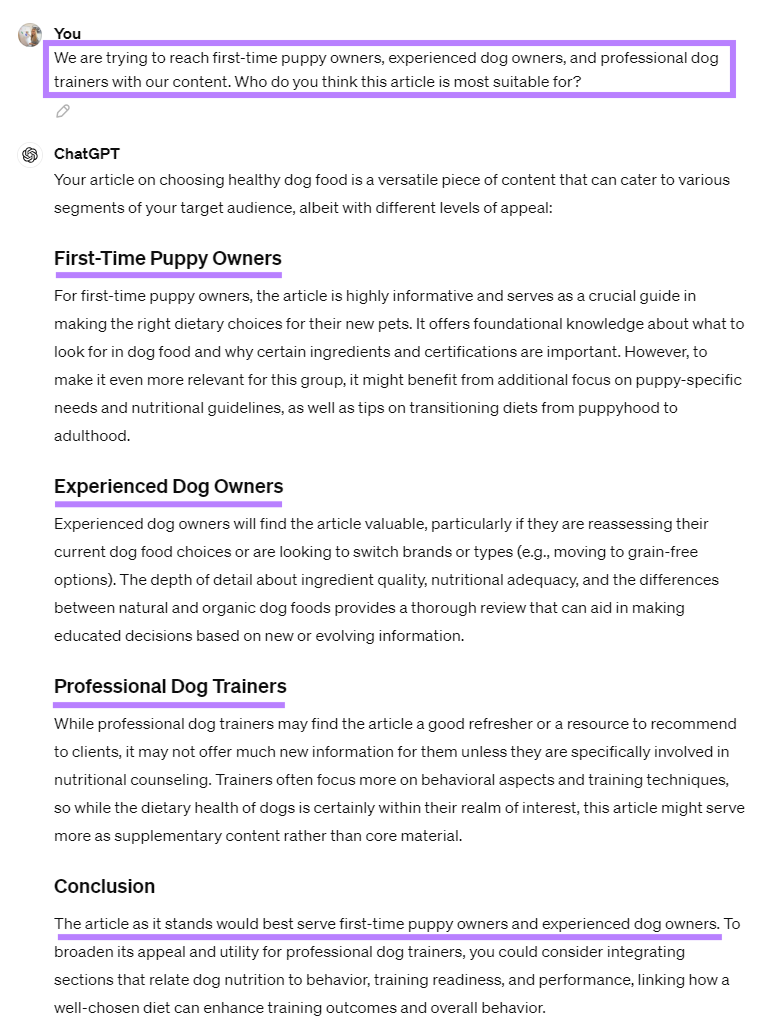
The AI tool tells you who the content is best suited for. And provides suggestions on how to make the content even more relevant. You can use this information to tweak your content. Which is likely to drive better results.
5. Repurposing Content
Content repurposing involves taking existing content and transforming it into different formats. Or modifying it for different platforms.
For example, you might create a YouTube video and then turn it into a blog post, an email newsletter, and a LinkedIn post.
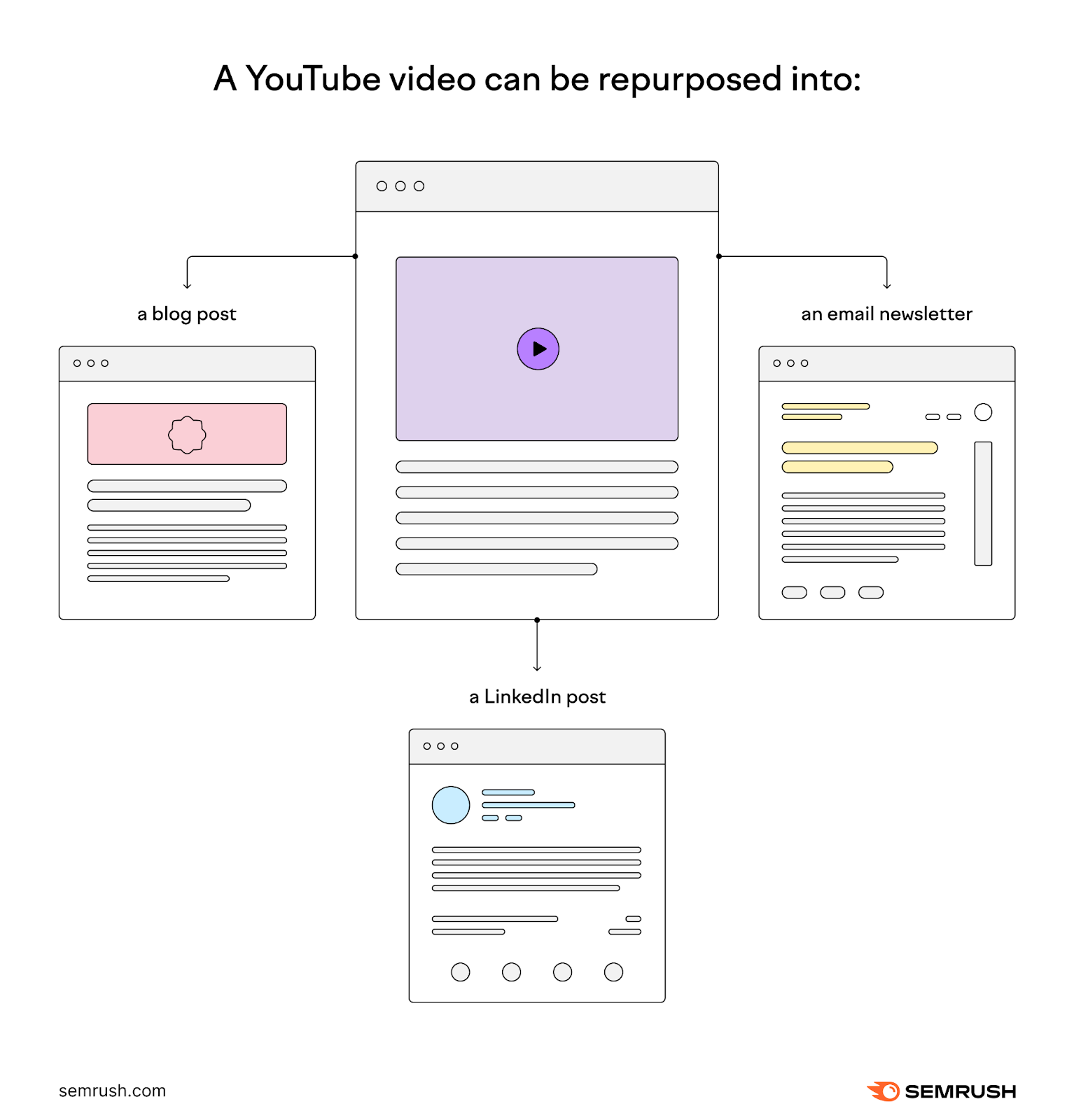
This approach allows your content to reach more people across different platforms.
Use Semrush’s AI Social Content Generator to turn existing content into posts, hashtags, and videos you can use on social media.
To get started, open the tool and paste your content, or part of your content, in the space provided. And hit “Generate.”

Based on the text you entered, the tool will generate the following:
- A social media video
- A social media image
- Text for a social media post
- Relevant hashtags
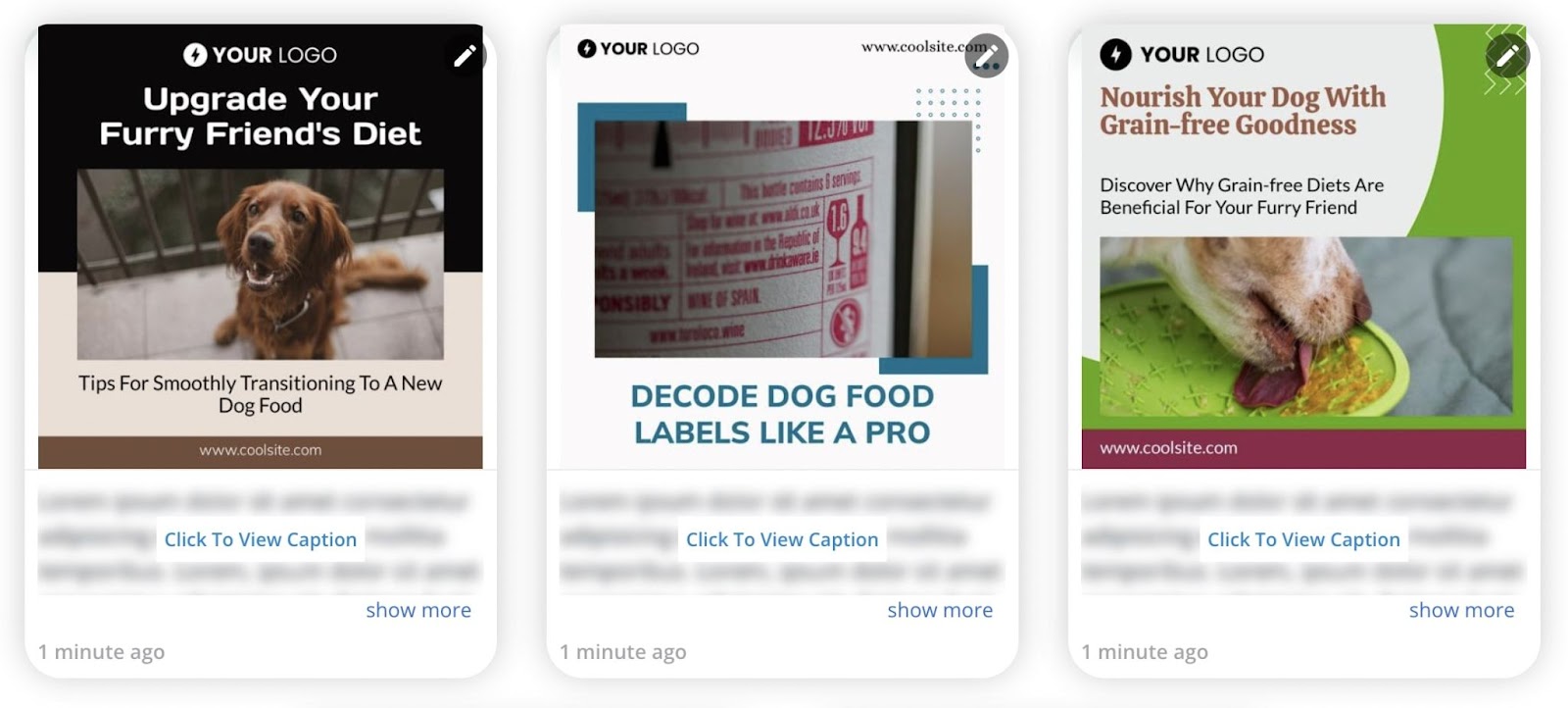
Look through the generated content. Then, choose the one you like and edit it. By clicking on the pen button at the top right corner of the post.
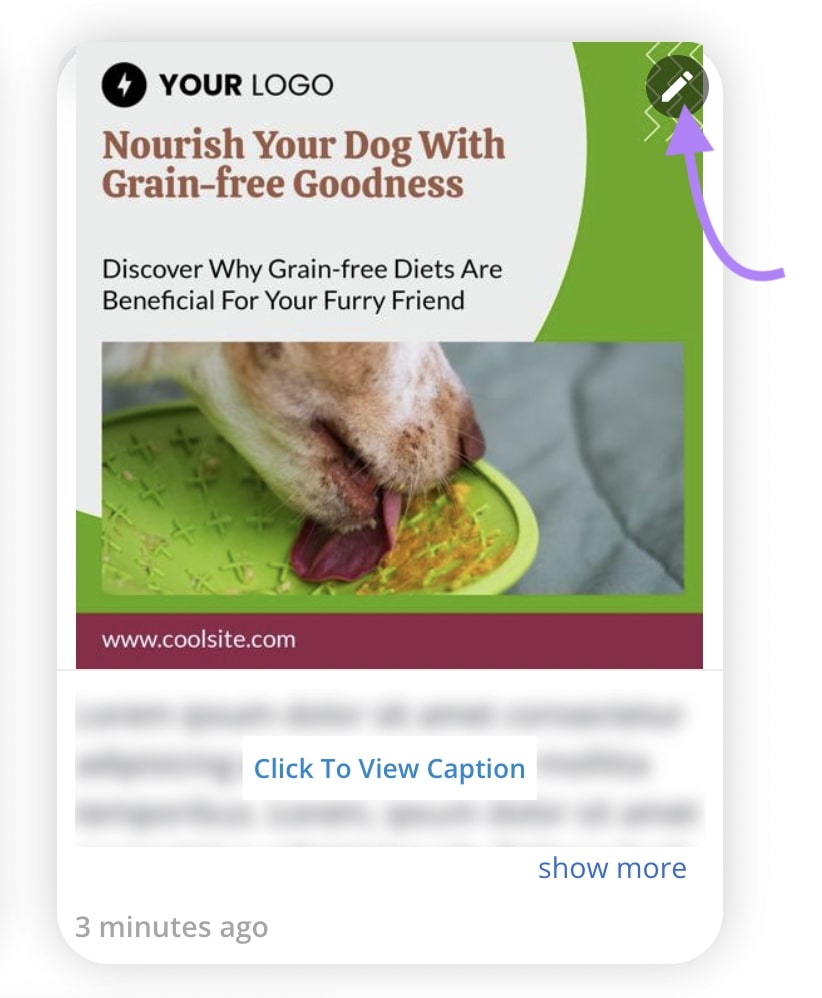
We recommend adding your logo, where applicable. And editing the caption for tone of voice, if needed.
Using AI makes it easy to turn your existing content into bite-sized, engaging chunks that are ideal for social media.
6. Creating Visuals
Visuals, such as stock photos, original photographs, and infographics, are important because they:
- Grab attention
- Simplify complex ideas
- Are memorable
- Encourage sharing
- Improve SEO (because they can show up in Google Images results, too)
If you generate a draft with ContentShake AI, the tool automatically includes free stock images in the article. And links to the original source. Like this:
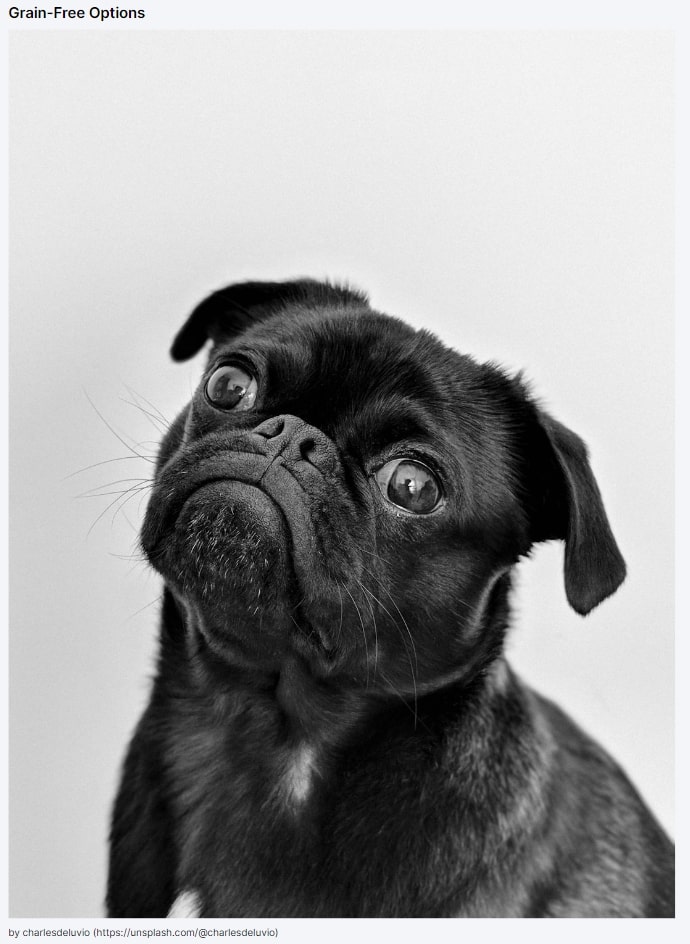
You can also use AI image generation tools to create your own visuals from scratch. Like with Canva’s Free Online AI Image Generator.
To start creating your own visuals, click “Generate AI Images.”
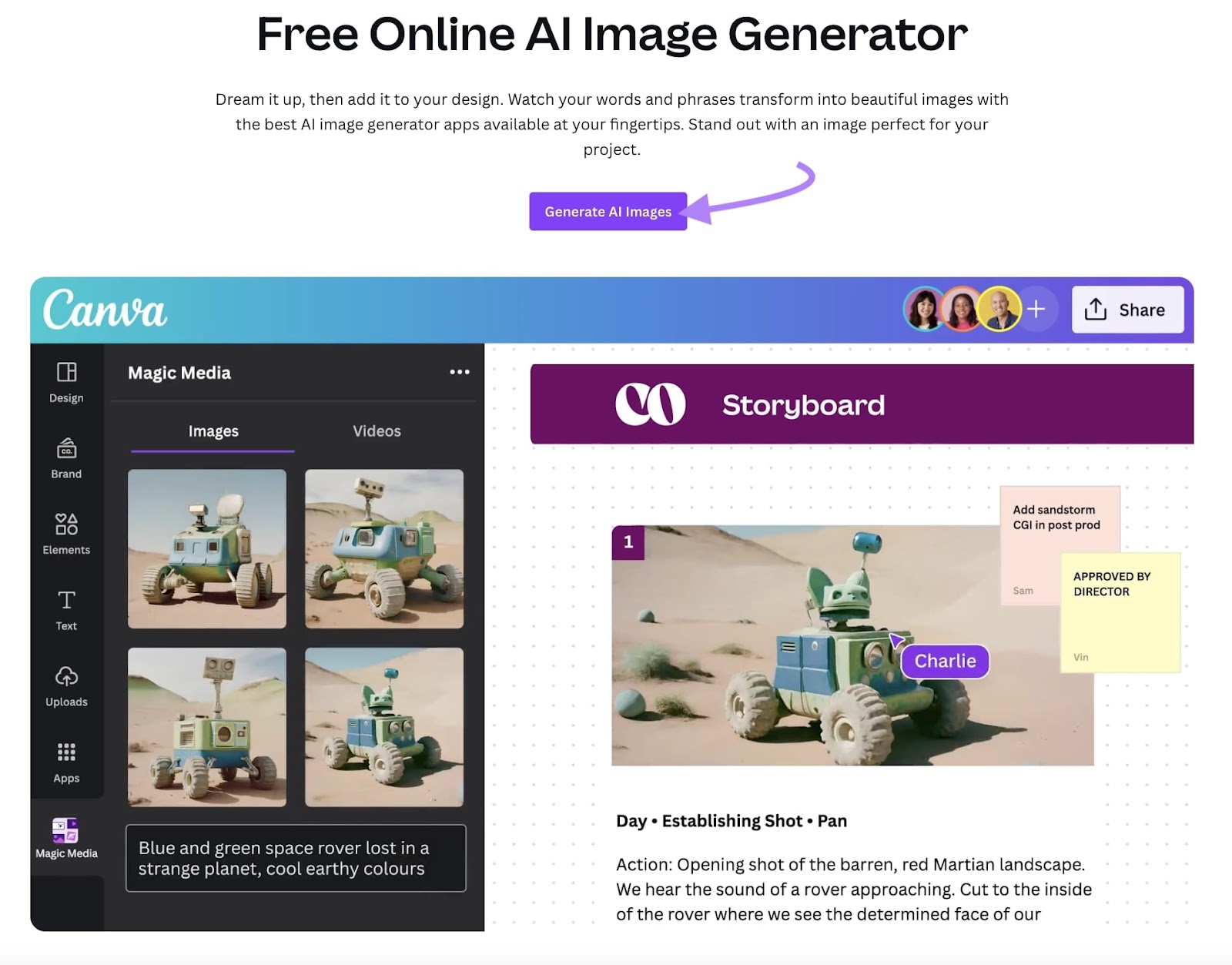
Decide whether you want to use a new or existing design. And your format.
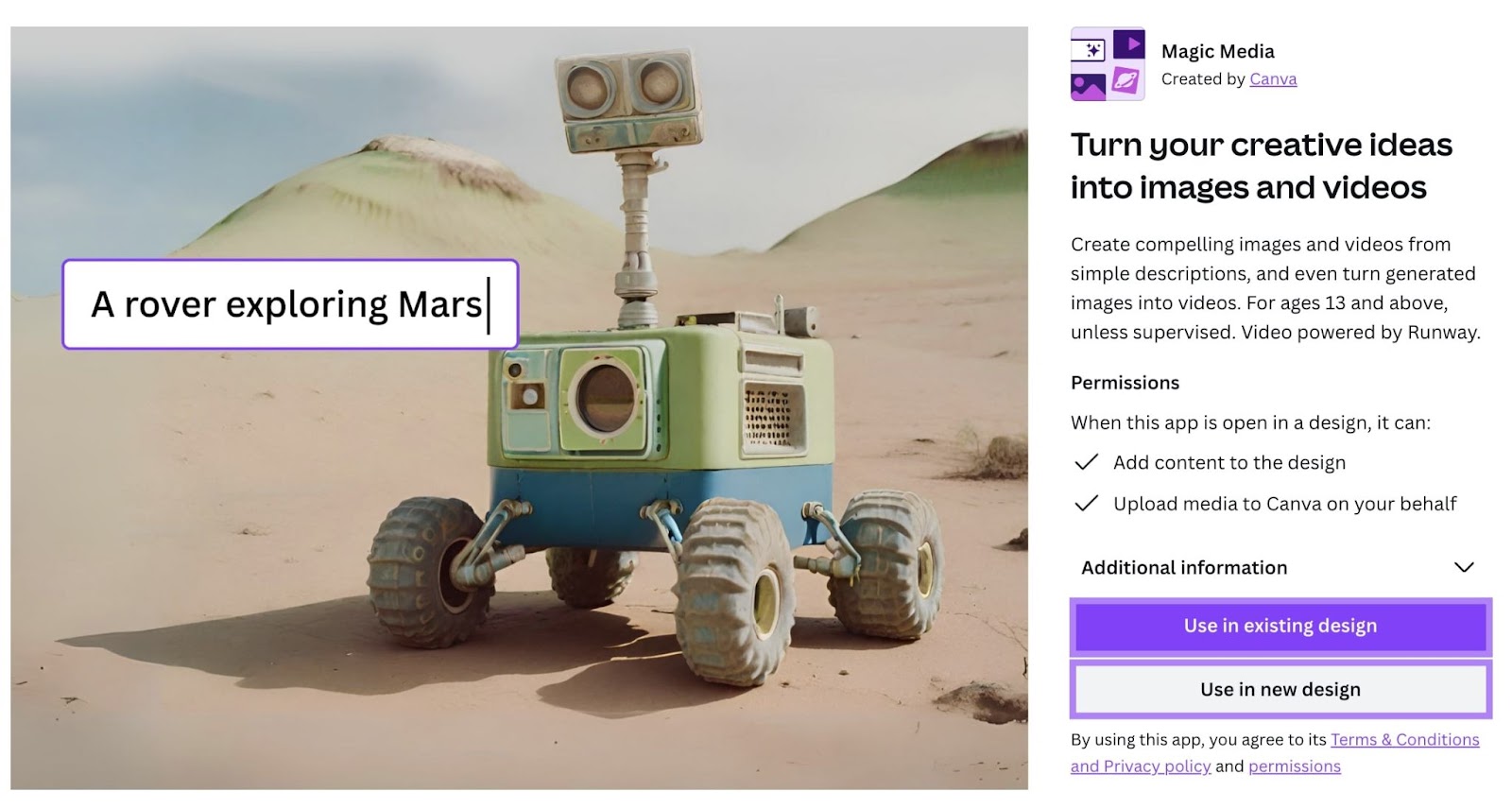
Then, describe what image you want to create. Like “cute puppy eating food.” And choose a style, like “Photo” (which is more realistic), “Dreamy,” or “Anime.” And set the aspect ratio, like “Square” or “Landscape.”
When you’re done, click “Generate image.”
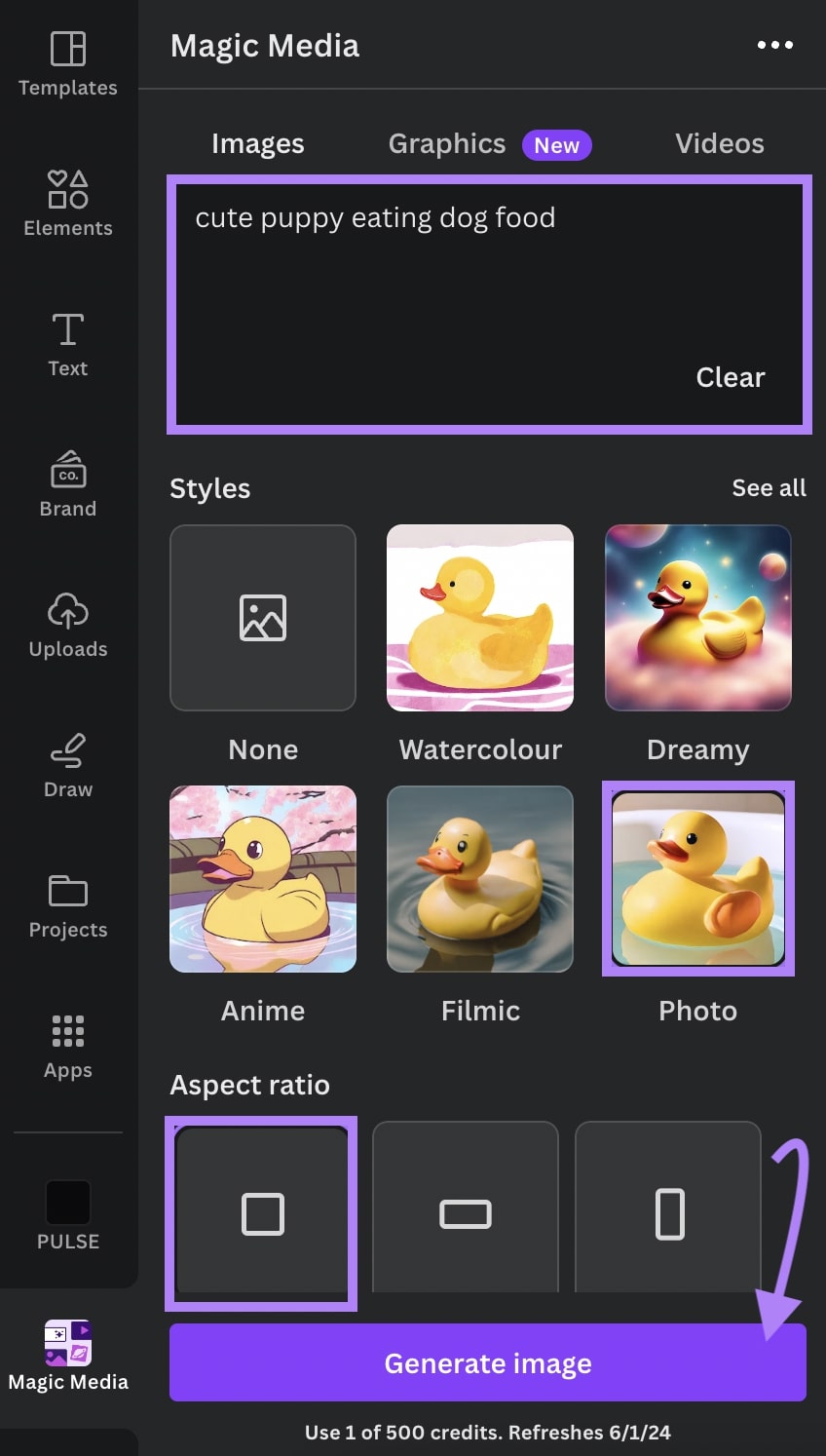
Canva will generate a few images for you to choose from. Click on each image to enlarge it. Or hit the “Generate again” button to get different results.
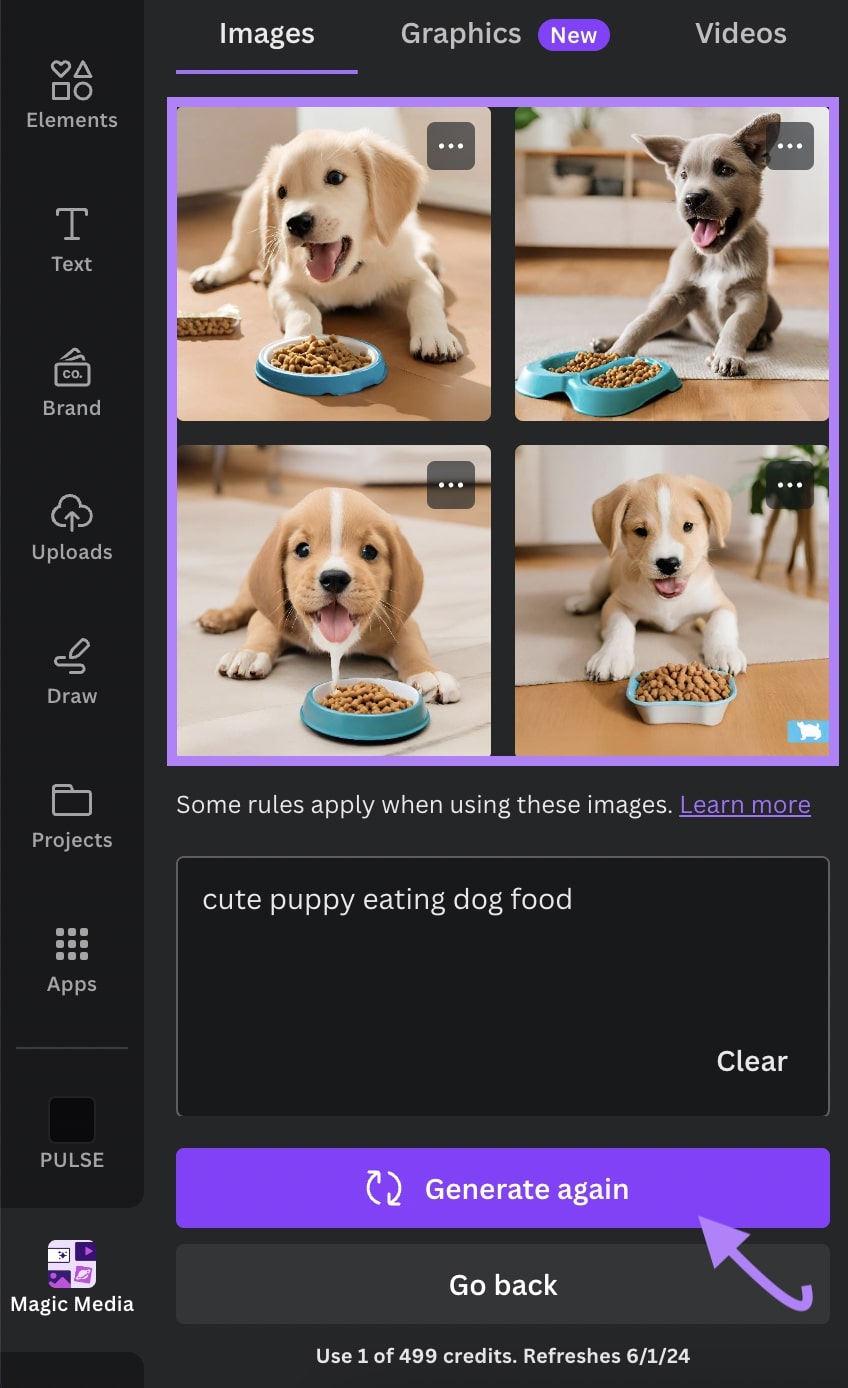
Once you’ve chosen an image, click the “Share” button to download it.

Images are a great way to make your content more engaging and break up blocks of text. And AI tools can help you generate simple images quickly.
3 Best Practices for Using AI for Content Marketing
Using AI in content marketing can streamline your workflow and spark creativity. But it’s important to use it wisely.
Here are some best practices to ensure you get the most out of AI tools. While maintaining quality:
1. Double-Check Everything
AI tools for content marketing can create text and images quickly. But it’s crucial to have a human review everything.
Here are some common issues you’ll want to watch out for:
- Factual accuracy: Verify all facts, figures, and data provided by AI against credible sources. Even small inaccuracies can undermine your credibility.
- Tone consistency: Ensure that the tone of the AI-generated content aligns with your brand’s voice. AI can sometimes generate content that feels out of sync with your usual style. Like super formal or too funny and enthusiastic.
- Grammar and syntax: Check for any grammatical errors or awkward sentence structures that AI might have overlooked. Correcting these will improve readability and professionalism.
- Contextual relevance: Make sure the content is contextually appropriate for your audience and the topic. AI might not fully grasp subtleties specific to certain contexts or cultural nuances.
- Unintended duplication: Look out for any sections that might be too similar to existing content (either your own or someone else’s). Anything you publish needs to be original to avoid plagiarism concerns and duplicate content.
- SEO optimization: Review keyword usage to ensure it aligns with SEO best practices and sounds natural. For example, AI might overuse keywords or put them in awkward places.
- Call to action: Think about the purpose of your content and what you would like the reader to do once they finish reading the piece. AI doesn’t know your marketing strategy as well as you do, so you might need to add or adjust the call to action.
2. Don’t Rely Solely on AI
Think of AI as a helpful assistant rather than the entire solution.
Yes, AI can help you come up with cool, new ideas. And pump out first drafts faster than a human could.
But to get best results, your content still needs that human touch.
3. Stay Compliant
Using AI responsibly involves understanding the legal and ethical implications, especially concerning data privacy and copyright laws. Here are some of the key concerns:
- Data privacy: AI systems use large datasets to learn and generate content. If you’re using a third-party tool, be careful not to share any confidential information. Because you don’t know how this data will be used. Some employers have banned certain AI tools for this reason.
- Copyright laws: AI analyzes existing content to generate new content. This can raise copyright issues, especially if the AI-generated version closely resembles the original. Or if the tool used copyrighted materials without permission. Make sure any content you post on your site is original.
- Bias and fairness: AI systems can be biased. For example, The Washington Post found that AI image generators often perpetuate gender and racial stereotypes. Review any content before you share it to ensure it reflects your brand’s values and standards.
If you decide to integrate AI into your content marketing strategy, you need to do it in a responsible way. So you remain in line with legal standards and your audience’s expectations.
Boost Your Content Marketing with AI
Whether you need a hand with the writing process or just want fresh ideas, AI content marketing tools can help you kickstart your content marketing efforts.
With ContentShake AI, you can generate exciting, new ideas and generate first drafts in record time. So you can create better content faster than ever before.
Try it today for free and discover the benefits of AI-powered content marketing.
Source link : Semrush.com
